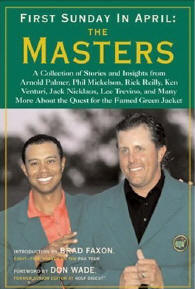First Sunday in April: The Masters
Golf book publishers focus on three primary seasons as they try to appeal to folks buying books about their own favorite sport or for their golf-nut relative or friend.
Father’s Day and Christmas time are two of them. The Masters Tournament, first major men’s golf tournament held each spring, is the other one.
Given that pattern, it’s perfectly understandable that a few weeks ago, the folks at Sterling Publishing sent out review copies of this newest entry in the long written record about Augusta National Golf Club, and the little ol’ tournament they hold there.
For this edition, however, there are no new insights into the 70-year history of the Masters.
That’s because this is a collection of some of the best of what’s already been written about it.
With an introduction by PGA Tour veteran Brad Faxon, and a Foreward by former Golf Digest Senior Editor Don Wade, the unnamed editors cobbled together a wide variety of pieces from books, magazines, newspapers, and the Internet. The mix includes some of the most well known Masters stories involving the greats of the game, including recent victors such as Tiger Woods and Phil Mickelson, but also some of the early winners, such as Byron Nelson and Ben Hogan.
It also features pieces that touch upon other distinctive elements of the golf course and tournament that millions of television viewers watch each year.
Many of these selections will be familiar to book-loving golfers who keep a fairly extensive library. There’s an essay by Herbert Warren Wind, perhaps the dean of American golf writers. The ironic counterweight to Wind, longtime golf writer Dan Jenkins, also has an article reprinted here.
Mark O’Meara’s popular victory in the 1998 Masters is recounted, using a chapter in John Feinstein’s The Majors. Passages from the semi-autobiographies of Arnold Palmer and Jack Nicklaus also make an appearance. Rick Reilly’s brutally funny attempt to caddie for 1963 Masters Champion Tommy Aaron, first told in Who’s Your Caddy?, is a welcome addition to the collection.
On the other hand, what I particularly like about this lengthy anthology are the pieces that might not have been selected, if the editors had assumed they should only reproduce what would be acceptable to the late Clifford Roberts, the autocratic co-founder of Augusta National.
Roberts’ role in running the golf course and the Tournament is a frequent mention in many of the pieces, as one might expect. Nonetheless, I was impressed that the editors ran a moving segment about Roberts that first appeared in Curt Sampson’s The Masters: Golf, Money and Power in Augusta Georgia. That book is a respectful but clear-eyed assessment of the event and the people who played a central role in Augusta National’s creation and management. Nonetheless, it would never be confused with an official, “authorized” history.
I also liked two short essays that dealt with the recent Martha Burk controversy, an odd attempt to further the cause of feminism, as I’ve written about previously.
Susan Reimer came back to sportswriting to cover this sideshow. She came away from the experience with a terrific perspective on some of the folks affected by the tournament. The editors also ran a great short piece by Bill Sammons of ESPN.com, in which he explains the extremely basic appeal of a mens-only recreational outlet.
I wouldn’t necessarily recommend reading this book straight through, especially during Masters Week. That would be a bit much, even for devout fans of Augusta National. On the other hand, it’s a very good collection on a single, well-covered topic.
It may also help inspire its readers to check out the lengthy publishing credits pages in the back of the book, and buy some copies of the original source materials.
And that would be well worth the effort.
Review date: April 6, 2008


